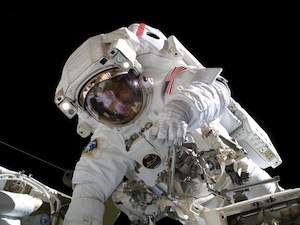
I hadn’t seen any classic space films for decades. So, upon receiving the invitation to speak at the October 2014 NASA Homeschool Day at Space Center Houston, I decided to revisit them.
Re-watching 2001: A Space Odyssey (1968) was the most fascinating, followed by Close Encounters of the Third Kind (1977). I added in a few others, plus decided I should plow black through the first three Star Wars films (now IV, V VI—go figure!).
While doing all this, I made notes on my observations and crocheted an afghan for our newest grandbaby. By the time I went to Houston, I was dreaming about asteroids and space hardware.
It’s good to revisit “classic” art, no matter what the format or theme. Time gives us valuable perspectives and enhances our appreciation for what was once cutting-edge creativity. It also reveals a lot about who we were when we first encountered the art.
Most interesting to me, though, was appreciating the undeniable influence that space films had on our modern musical sensibilities. Stanley Kubrick’s decision to set aside a score composed for 2001: A Space Odyssey and go instead with pre-existing music from three “classical” composers was radical. Instantly, the opening trumpet blast of Richard Strauss’s 19th-century tone poem Also Sprach Zarathustra became synonymous with Space: dah . . . dah . . . dah . . . . . . . ba-BANG . . . du-du-du-du-du-du (tympani).
Kubrick also chose an unlikely piece by Johann Strauss, Jr. (no relation to Richard Strauss): the iconic Blue Danube Waltz. It’s music that most people associate with the swirl of dresses at the Viennese royal gardens. Yet, instantly, it too became the musical signature of rotating planets and revolving spacecraft.
But Kubrick’s most radical decision was his use of unsettling music by Hungarian composer György Ligeti (1923-2006). You can read about how this came about, initially without Ligeti’s own involvement! But, as a result, countless film-goers absorbed and embraced cutting edge new music, sounds as avant-garde as anything could get in 1968. Wordless choirs pulsating amorphous “ahs”; edgy musical cello lines that disoriented the film-goers’ sense of melody—all of it unsettled and hypnotized listeners. The effect was brilliant.
From that point on, the movie lover, especially the space-movie fan, was game for any sounds the film offered. Electronic music played a huge role in the new musical tapestry of space-sound, as well as vivid juxtapositions of harsh musical fragments that would cause most people to flee a concert hall. New music became utterly hip in the context of Space War.
The ruling dynasty of John Williams and his wonderful scores for Close Encounters of the Third Kind and E.T. brought space music back in line with traditional Hollywood film scoring. Lyrical signature themes (think of bicycle-mounted E.T. soaring past the moon) and symphonic development of these themes (the “communications” theme based on Kodaly gestures in Close Encounters of the Third Kind) represented a continuation of orchestral trends transplanted to Hollywood in the 1930s and 40s by a powerhouse generation of European and Russian refugees.
Think about revisiting these the classic space films. Find out what your kids’ “take” on space movies is, and ask how they think music for space ought to sound. Be prepared for them to comment negatively on the (at the time spectacular) graphics in these films. In fact, you might start the conversation by speculating on how 2001 (perhaps the year of their birth?) looked from the vantage point of the late 1960s. Could that really have been the distant future?
Art changes, grows, and opens ever-new doors, particular as it ages and deepens. And that applies to space films too.



